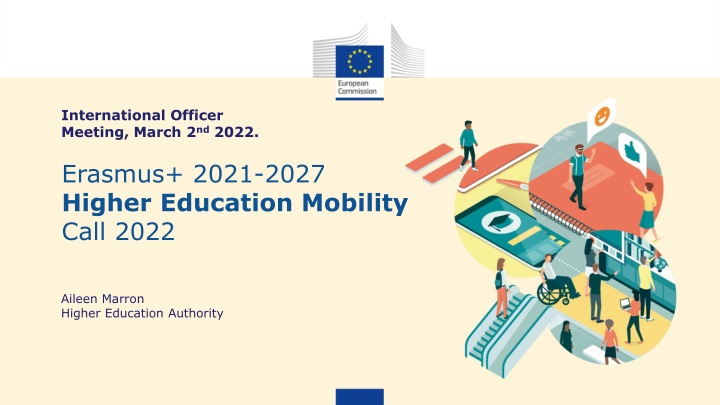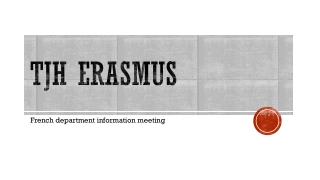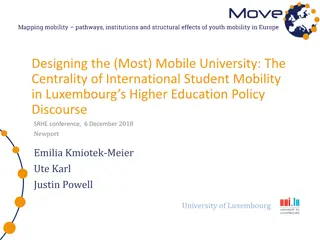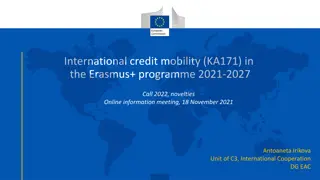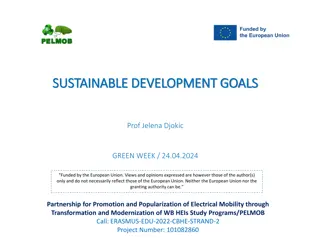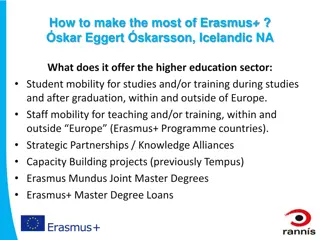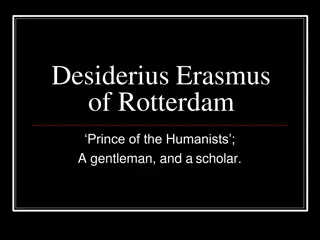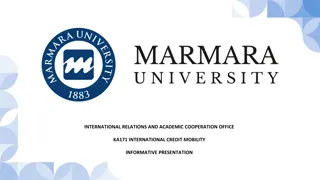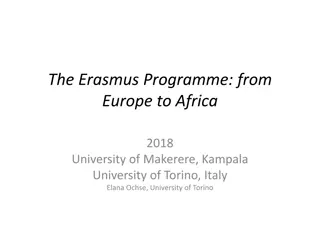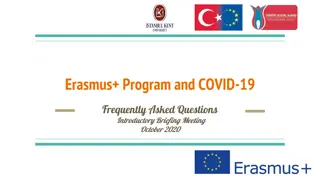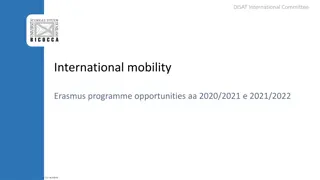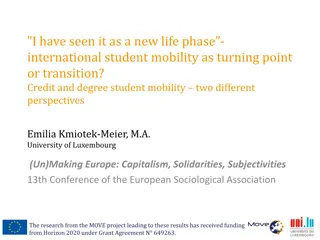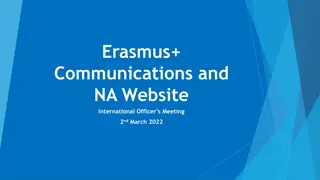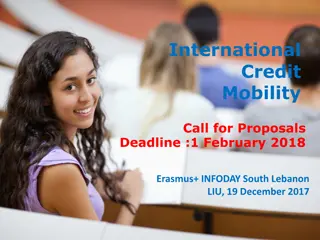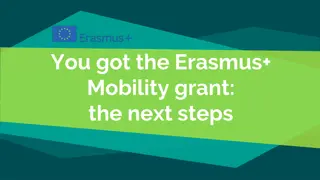Erasmus+ 2021-2027 Higher Education Mobility Call 2022
International Officer Meeting on March 2nd, 2022 to discuss budget allocations for KA131, KA171, and KA220 programs. Details on blended student and staff mobility options provided, emphasizing virtual components for collaborative learning exchange.
Download Presentation

Please find below an Image/Link to download the presentation.
The content on the website is provided AS IS for your information and personal use only. It may not be sold, licensed, or shared on other websites without obtaining consent from the author.If you encounter any issues during the download, it is possible that the publisher has removed the file from their server.
You are allowed to download the files provided on this website for personal or commercial use, subject to the condition that they are used lawfully. All files are the property of their respective owners.
The content on the website is provided AS IS for your information and personal use only. It may not be sold, licensed, or shared on other websites without obtaining consent from the author.
E N D
Presentation Transcript
International Officer Meeting, March 2nd 2022. Erasmus+ 2021-2027 Higher Education Mobility Call 2022 Aileen Marron Higher Education Authority
1. 2022/23 Budget Allocations
KA131 2022/23 Budget Allocation Budget available: 14,368,465 No. of Applications submitted: 27 Total demand for mobilities: 10,767, an increase of circa 20% Expected grant notification date: early May 2022
KA171 2022/23 Budget Allocation Budget available: 2,842,677 No. of Applications submitted: 13 Expected grant notification date: mid July 2022
KA220 2022/23 Budget Allocation Budget available: 1,240,482 Applicant deadline: March 23rd 2022 Expected grant notification date: end of July 2022
2. Blended mobility and Blended Intensive Programmes
Blended student mobility WHAT? Long-term or short-term physical mobility combined with compulsory online learning ( virtual component ) before, during or after physical mobility WHO? Any student (from any study field and study cycle) HOW? Three ways: 1. Individual long-term blended mobility 2. Group blended mobility to participate in a blended intensive programme 3. Individual short-term blended mobility, in particular for students with fewer opportunities and specific situations WHEN? Duration of 5-30 days for short-term physical mobility or 2-12 months HOW MUCH? Minimum 3 ECTS credits for both components (short-term mobility)
Blended staff mobility WHAT? Short-term physical mobility combined with compulsory online learning ( virtual component ) before, during or after physical mobility HOW? 1. Individual blended staff mobility for teaching or training 2. Group blended staff mobility to participate in a blended intensive programme WHO? Staff as learners OR staff as teachers/trainers WHEN? 1. Duration of 1-60 days for physical mobility 2. Duration of 5-30 days for physical mobility for staff learners in blended intensive programmes
Blended mobility: virtual component Before, during and/or after physical mobility mandatory virtual component facilitating collaborative online learning exchange and teamwork Must work simultaneously on specific assignments integrated in the programme and count towards the overall learning outcomes
Blended intensive programmes: objectives Create more opportunities for blended mobility Innovative learning, training and teaching Stimulate transnational and transdisciplinary courses for students Quality Quality
Blended intensive programmes: implementation Short, intensive and joint blended mobility courses for students or academic and administrative staff Short-term physical group mobility abroad (5-30 days) for learners Compulsory virtual component Digitalisation Digitalisation
Blended intensive programmes: requirements Minimum 3 HEIs from 3 Programme Countries Minimum 15 participants (learners via blended mobility) Minimum 3 ECTS credits for students Recognition
Blended intensive programmes: funding Organisational support for blended intensive programmes: For coordinating, developing and running the programme Costs such as staff costs, equipment and room rental, communication, activities From 6000 to 8000 per programme, dependent on number of participants and independent of duration 400 EUR per participant for max 20 mobile learners taken into account
3. International mobility
More opportunities for international mobility of students and staff: why the international opening? Student and staff mobility to any Partner Country in the world under call Objectives: 1. Development of relevant skills for students and staff 2. Sustainable international cooperation of HEIs Greater inclusion and accessibility: all ECHE holders, every year First international cooperation or diversification of destinations Quality assurance: full integration into the quality framework & cycle Synergies and complementarity with external policy funds
International mobility: who & where call 2021 Several countries Widest geographical scope
International mobility: funding cap
International mobility: KA131 vs. ICM Dimension KA131 international KA107 / ICM Objective/focus Programme Countries Partner Countries Funding source EU internal policy funds EU external policy funds Funding allocation All ECHE holding HEIs, every call year / sustainable Worldwide, no funding priority, diversification expected, bottom-up choice Outgoing Best HEIs / competition, time gaps possible Worldwide, funding priorities, mix top-down/bottom-up choice Geographical scope Mobility flows (2021) Mostly incoming Participants Any students and staff Some restrictions on student cycles At application stage mostly Choice of partners During implementation
International mobility: Lifecycle 1. Erasmus Policy Statement and mobility consortium accreditation: Include internatl. mobility in strategy 4. Sign LA (in the future online - ESCI) 2. Application form: Estimate budget share for international mobility 3. Sign updated inter- institutional agreement for international mobility aligned with KA171
International mobility: funding modalities Main principle: All funding modalities applicable to KA131 intra-European mobility also apply to international mobility, including: Flexibility (zero grants, partial zero grants) Protection of funding for those with fewer opportunies (top-ups, travel, inclusion support) Grant rates for individual support: Aligned with KA107 rates: monthly 700 EUR (students) / daily 180/126 EUR (staff) European Partner Countries of Regions 5 and 14 like Programme Countries Short-term mobility (blended/doctoral): two daily rates: 70/50 EUR Exception: No top-up amount for traineeships
International mobility: travel support Students and staff Based on distance band Beneficiary opt-out for travel support for international student mobility if student not with fewer opportunities Exceptional costs for expensive travel: 80% of actual eligible travel costs Green travel: financial incentive below 4000km + funded travel days
4. Doctoral mobility
Doctoral mobility more opportunities Doctoral candidates can now go on short-term mobility even when they only have a student status. Eligibility Before Issue Novelty Doctoral candidates with only student status Long-term study mobility and traineeship (2-12 months) No study programme at PhD level Teaching responsibilities Short-term study and traineeship mobility (5-30 days) Virtual component optional
5. Grant Levels
Participants: Increase in individual support Long-term intra-European student mobility: Base amounts: ranges increased by 15% Top-up amounts: 1. Fewer opportunities: fixed 250 , no opt-out 2. Traineeships: fixed 150 , cumulative
Simplified grant levels Novel short-term student mobility: Individual support base: 70 (up to 14th day) and 50 (15th-30th day) Individual support top-up fewer opportunities: 100 (mobility up to 14 days), 150 (15-30 day mobility) Extra travel support for participants with fewer opportunities and international mobility Up to two funded travel days Green travel: financial incentive + up to four funded travel days
Participants with fewer opportunities in HE Aspects Erasmus+ 2014-2020 Erasmus+ 2021-2027 Target population Students of a disadvantaged background Students/recent graduates with fewer opportunities Funding of costs (unit costs) Top-up: 100-200 , national criteria Top-up: fixed 250 , national criteria Application of top-ups Opt-out of top-up All countries, no opt-out + traineeship top-up Inclusion support Students and staff Additional costs (real costs) Special needs support Students and staff Physical, mental and health- related conditions With fewer opportunities, in particular physical, mental and health-related conditions + preparat. visits 100% of costs + organisation overhead 100 Criteria Cost coverage Up to 100% of costs
Green mobility for students and staff Use of greener means of transport encouraged Financial incentive for green travel: Higher travel support: If extra travel support: 30 to 80 (100 to 4000 km) If not (regular students), 50 on top of mobility grant Extra funded travel days: Up to 4 additional days for a return trip
HEIs: Rewarding extra efforts Organisational support for mobility: 15% increase: Up to 100thparticipant: 400 per participant From 101st participant: 230 per participant
